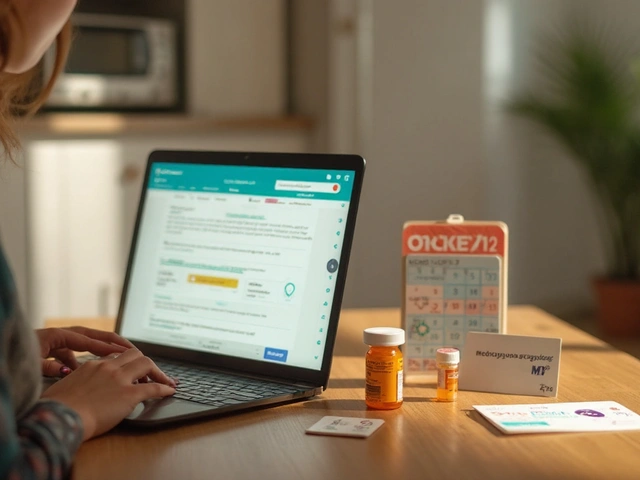
If you’re googling Aceon at 2 a.m. because your clinician just mentioned it, you want straight answers. This medication lowers blood pressure and protects the heart and kidneys, but timing, dose, and a few safety rules make a real difference. Here’s the plain-English, no-drama guide I wish every patient got in the exam room.
TL;DR: Aceon (Perindopril) at a Glance
- What it is: Brand name for perindopril, an ACE inhibitor used for high blood pressure, heart protection in coronary artery disease, and kidney protection in diabetes/CKD.
- How it works: Relaxes blood vessels and lowers aldosterone; BP usually drops within hours, with full effect in 1-2 weeks.
- Typical dose: Start 4 mg once daily (often in the morning); target 8-16 mg daily if tolerated. Lower starts for kidney issues, older adults, or folks on diuretics.
- Big watch-outs: Pregnancy (do not use), history of angioedema, high potassium, severe kidney artery narrowing. Recheck labs (creatinine, potassium) 1-2 weeks after starting or changing the dose.
- Side effects: Dry cough, dizziness, rise in potassium, small bump in creatinine, rare angioedema (emergency). Avoid potassium supplements and salt substitutes unless advised.
- Availability: In the U.S., generic perindopril erbumine is common; the Aceon brand can be hard to find. Generics are usually inexpensive with coupons or insurance.
How to Start and Take Aceon Safely (Step-by-Step)
Here’s the simple start plan I give friends and readers-because setup matters more than any fancy pill sorter.
Step 1: Make sure it’s a fit.
- Good candidates: High blood pressure; stable coronary artery disease; diabetes or chronic kidney disease with hypertension; protein in urine.
- Do not use: Pregnancy, trying to conceive, or breastfeeding without specialist input; history of angioedema with any ACE inhibitor; known allergy to perindopril; on sacubitril/valsartan (need a 36-hour washout before switching); severe bilateral renal artery stenosis.
- Talk to your clinician if: Potassium is ≥5.0 mEq/L, eGFR is low, or you’re taking lithium, potassium-sparing diuretics (spironolactone, eplerenone), or aliskiren. These need a plan.
Step 2: Baseline checks.
- Get a basic metabolic panel: creatinine/eGFR and potassium.
- Log a week of home BP readings (morning and evening, seated, arm at heart level). I keep mine in my phone between school drop-offs.
Step 3: Start dose.
- Most adults: 4 mg once daily in the morning. Food won’t make or break it; take it the same way each day.
- On a diuretic (like hydrochlorothiazide) or prone to dizziness? Ask about starting at 2 mg for a few days.
- Kidney function reduced (eGFR <60)? Many clinicians start lower and go slower.
Step 4: First week routine.
- Check BP at home daily for the first 3-5 days, then every other day.
- Hydrate normally. If you feel lightheaded on standing, sit, hydrate, and recheck BP.
- Avoid new NSAIDs (like ibuprofen) unless your clinician okays it.
Step 5: Lab recheck.
- Repeat creatinine/eGFR and potassium about 7-14 days after starting or changing dose.
- Expected: a small bump in creatinine (up to ~30% from baseline) can be okay; a bigger jump or potassium >5.5 needs attention.
Step 6: Titrate to goal.
- Typical targets: 8-16 mg once daily if tolerated for hypertension; in stable coronary disease, many aim for 8 mg daily after two weeks if BP allows.
- BP goal (most adults): <130/80 mm Hg, per U.S. cardiology guidelines. Individual goals vary-age, symptoms, and other conditions matter.
Step 7: What to do if...
- You miss a dose: Take it when you remember unless it’s close to the next dose. Don’t double up.
- You get a dry cough: If it’s mild, give it 2-4 weeks; if it’s constant or bothersome, call your clinician-an ARB may replace it.
- Your BP is too low (e.g., <90/60 with symptoms): Hold the next dose and call for advice, especially if you’re dehydrated or sick.
- Face/lip/tongue swelling or trouble breathing: Call emergency services. That’s angioedema, and it’s rare but serious.

Side Effects, Risks, and Interactions (What’s Common vs. What’s Serious)
Most people do well on perindopril. The trick is knowing what’s normal, what needs a call, and what’s a hard stop.
Common and usually manageable
- Dry, tickly cough (5-20%). Can show up after days or weeks. It goes away after stopping.
- Dizziness or fatigue in the first week. Often improves as your body adjusts.
- Mild rise in creatinine. This reflects less pressure on kidney filters. Your clinician watches trends, not one lab number.
Less common but important
- High potassium (hyperkalemia): Muscle weakness, palpitations, or no symptoms at all. Risk goes up with CKD, potassium supplements, or potassium-sparing meds.
- Angioedema: Sudden swelling of face, lips, tongue, or throat. Higher risk if you’ve had it before, are Black, or use certain DPP-4 inhibitors. Stop the drug and get emergency care.
- Kidney function drop beyond expected: If creatinine spikes >30% or urine output falls, you need a check-in and often a dose change or stop.
Drug and food interactions that matter
- Potassium boosters: Potassium chloride, salt substitutes, spironolactone, eplerenone, amiloride, triamterene. Ask if they’re still appropriate.
- NSAIDs: Frequent use (ibuprofen, naproxen) can blunt BP control and strain kidneys, especially with dehydration or diuretics.
- Lithium: ACE inhibitors can raise lithium levels. If both are needed, you’ll need careful monitoring.
- Aliskiren or dual ACE/ARB therapy: Avoid combo in diabetes or kidney disease-higher risk without added benefit in most cases.
- Sacubitril/valsartan (ARNI): Separate by 36 hours to lower angioedema risk.
- Alcohol: Can add to dizziness. Moderate intake is usually fine, but watch your BP response.
Pregnancy and breastfeeding
- Pregnancy: Do not use. ACE inhibitors can harm fetal kidneys and cause fetal death, especially in 2nd/3rd trimester. If pregnancy occurs, stop and call your clinician immediately.
- Breastfeeding: Perindopril’s presence in human milk is limited/uncertain. Safer alternatives often preferred-ask your pediatrician/OB.
Evidence notes: Benefits and risks are well-documented in FDA prescribing information and major trials: EUROPA (stable coronary disease, perindopril 8 mg reduced CV events), PROGRESS (perindopril plus indapamide reduced recurrent stroke), and ADVANCE (perindopril/indapamide lowered vascular events in type 2 diabetes). U.S. cardiology guidelines recommend ACE inhibitors for hypertension and for patients with diabetes, CKD with albuminuria, or coronary disease when appropriate.
Comparisons and Alternatives (Where Aceon Fits)
Perindopril sits in the ACE inhibitor family with lisinopril, enalapril, and ramipril. All lower BP well. Choice often comes down to dose schedule, side effects, cost, and what else you’re treating (heart disease, kidney disease, diabetes).
| Medication | Typical Daily Dose | Half-life | Notable Pros | Common Trade-offs | Approx. U.S. Generic Cost/mo (2025) |
|---|---|---|---|---|---|
| Perindopril (Aceon) | 4-16 mg once daily | 3-10 hrs (active metabolite) | Strong data in stable CAD; once-daily; kidney/heart protective | ACE cough risk; rare angioedema | $6-$20 with coupons/Part D |
| Lisinopril | 10-40 mg once daily | ~12 hrs | Very low cost; single daily dose; widely available | Similar cough/angioedema risk | $4-$10 |
| Enalapril | 10-40 mg in 1-2 doses | ~11 hrs | Well-studied; flexible dosing | Sometimes twice daily | $5-$12 |
| Ramipril | 5-10 mg in 1-2 doses | 13-17 hrs | Post-MI and high-risk CV prevention data | Cough similar to others | $6-$15 |
| Losartan (ARB) | 50-100 mg once daily | ~2 hrs (active ~6-9) | No ACE cough; kidney/diabetes benefits | Less bradykinin effect; rare angioedema still possible | $5-$12 |
| Perindopril/Indapamide (combo) | e.g., 2/0.625 to 8/2.5 mg | - | Strong stroke/CV prevention data (PROGRESS/ADVANCE-like) | More electrolyte monitoring | $15-$40 |
| Perindopril/Amlodipine (combo) | varies by product | - | One pill for BP; covers different pathways | Ankle swelling from amlodipine | $20-$50 |
Best for / Not for
- Best for: Adults needing once-daily BP control, especially with stable coronary artery disease, diabetes with albuminuria, or early CKD.
- Not for: Pregnancy; past angioedema on ACE inhibitors; people who cannot tolerate the cough and prefer an ARB; those on sacubitril/valsartan without the needed washout period.
Practical tip: If a dry cough starts and won’t quit, an ARB like losartan often gives similar benefits without the cough. If you’re already on a diuretic, ask about a perindopril/diuretic combo to simplify pills-just be ready for closer electrolyte checks.

Checklists, Real-Life Examples, FAQ, and Next Steps
Here’s the part people screenshot. Keep it close until your routine clicks.
Quick checklists
- Before starting
- Baseline BMP: creatinine/eGFR, potassium
- Home BP cuff that fits your arm
- List of all meds/supplements (especially potassium, NSAIDs, lithium)
- Pregnancy status if relevant
- First 2 weeks
- BP log: daily first 3-5 days, then every other day
- Lab recheck at 1-2 weeks
- Watch for cough, dizziness, swelling, or unusual fatigue
- Ongoing
- BP checks 2-3 times/week once stable
- Labs every 3-6 months if stable (sooner if dose changes or CKD)
- Keep a sick-day plan: if dehydrated from vomiting/diarrhea, hold perindopril until you’re drinking/peeing normally and call for advice
Real-life examples
- Newly diagnosed hypertension (age 52, no other issues): Start 4 mg each morning. BP falls from 152/92 to 134/82 over 10 days. Labs at day 10 show creatinine up from 0.9 to 1.0 (fine), potassium 4.6 (fine). Dose increased to 8 mg; BP averages 126/78 by week 4.
- Type 2 diabetes with albumin in urine (age 58): Start 2-4 mg due to eGFR ~55. Close lab checks. Target 8 mg if tolerated. Add low-dose thiazide or calcium-channel blocker if BP still above 130/80.
- On hydrochlorothiazide already (age 67): Start 2 mg for 3-5 days to avoid lightheadedness, then 4 mg. If BP stalls above goal, adjust to 8 mg or consider a single-pill combo.
Mini-FAQ
- Is the Aceon brand still sold in the U.S.? The brand can be hard to find. Pharmacies usually stock generic perindopril erbumine, which works the same.
- Can I cut or crush perindopril? Standard tablets can usually be split if scored; check your specific product. Avoid crushing if your label says not to.
- How fast will my BP drop? Often within hours, with the full steady effect in about 1-2 weeks.
- What if I get that ACE cough? If it’s mild, give it a couple of weeks. If it’s persistent or keeps you up at night, ask about switching to an ARB.
- Can I take it with metformin, statins, or SGLT2 inhibitors? Yes, commonly combined. Watch kidney labs as directed.
- What about surgery or dental work? Keep your med list handy. Some surgeons prefer holding ACE inhibitors the morning of major surgery; follow their instructions.
- Can I exercise on it? Please do. Warm up, hydrate, and track how your BP responds.
- Does it help the heart beyond BP? Yes. Trials like EUROPA showed fewer cardiovascular events in stable coronary disease at 8 mg daily.
Next steps by situation
- I’m new to Aceon and anxious: Set reminders, measure BP at the same times, and plan your 1-2 week lab check now so it doesn’t slip.
- My BP is still above 130/80 after 2-4 weeks at 8 mg: Share your home BP log. Many people need a second med (thiazide-like diuretic or calcium-channel blocker).
- I developed a dry cough: Rule out a cold. If it sticks around, call about switching to an ARB.
- I have CKD or high potassium: You can still benefit, but you’ll need a lower start and closer labs. Avoid potassium supplements and salt substitutes.
- I might be pregnant: Stop the medication and call your clinician right away for safer alternatives.
When to call urgently: Face, lip, or tongue swelling; trouble breathing; fainting; chest pain; potassium ≥6 on a recent lab; or no urine output.
Author’s note: I live in Portland and juggle school runs with health writing. My rule with blood pressure meds-make them boring. Set your routine, automate refills, and let the numbers do the talking.
Credible sources behind this guide: U.S. FDA Prescribing Information for perindopril erbumine (2024 update); 2024 AHA/ACC hypertension guidance; EUROPA (Lancet 2003), PROGRESS (Lancet 2001), ADVANCE (NEJM 2007). If your situation is nuanced-heart failure meds, kidney disease, pregnancy-ask your clinician to tailor the plan.





Comments (11)
Dan Rua
Just started this last week after my doc pushed me to try it instead of lisinopril-my cough was driving me nuts. So far, zero cough, BP’s down to 128/76. Still a little dizzy in the morning, but I’ve been drinking more water and it’s getting better. 😊
Mqondisi Gumede
ACE inhibitors are just corporate medicine dressed up as science. You think your kidneys need protecting but you’re just poisoning yourself with synthetic peptides. Nature gave us garlic and deep breathing. Why are we still swallowing pills like obedient sheep
Douglas Fisher
I just want to say how incredibly thoughtful and thorough this guide is… Seriously, the step-by-step breakdown, the lab timing, the real-life examples-it’s clear you’ve put so much care into this. I’ve shared it with my mom who’s on perindopril, and she said it finally made sense to her. Thank you. 🙏
Albert Guasch
Perindopril, as a long-acting angiotensin-converting enzyme inhibitor, demonstrates a clinically significant reduction in cardiovascular morbidity and mortality in patients with stable coronary artery disease, as evidenced by the EUROPA trial. Its pharmacokinetic profile supports once-daily dosing with sustained 24-hour coverage, making it an optimal agent for adherence in chronic hypertension management. Additionally, its renoprotective effects in diabetic nephropathy are mediated via intrarenal hemodynamic modulation and reduction in proteinuria.
Ginger Henderson
Why does everyone act like this is the first time someone’s ever written about ACE inhibitors? I’ve been on lisinopril for 12 years and this feels like a Wikipedia page with extra steps.
Bethany Buckley
While the empirical data presented is methodologically sound, I find the pedagogical framing overly utilitarian. The reduction of cardiovascular pathology to a checklist of BP targets and lab values… it’s a clinical dystopia. Where is the phenomenology of the body? The quiet dignity of hypertension as a silent teacher? 🌿
Stephanie Deschenes
This is exactly the kind of info I wish my doctor had given me. I started at 2mg because I was on HCTZ, and the dizziness was awful. After a week, I went to 4mg and now I feel great. Just remember: if you’re tired, don’t assume it’s the med-could be sleep, stress, or coffee. Give it time.
Cynthia Boen
Why are we still using 20-year-old guidelines? This guide reads like a 2010 pamphlet. We’ve got real data now on SGLT2 inhibitors and GLP-1s-why are we still clinging to ACE inhibitors like they’re magic? This is outdated.
Amanda Meyer
I appreciate the depth here, but I’m curious-why is perindopril prioritized over ramipril or lisinopril in patients with CKD? The guidelines don’t strongly differentiate, yet this guide implies it’s superior. Is there a specific reason, or is this preference anecdotal?
Jesús Vásquez pino
Did anyone else notice they didn’t mention that perindopril is basically the same as ramipril but costs more? And that the brand Aceon is basically dead in the US? This feels like a pharma ad disguised as patient advice. Just get generic lisinopril for $5.
hannah mitchell
My dad’s on this. He’s 74, has diabetes, and the dry cough was brutal. Switched to losartan and it vanished in 3 days. I’m glad someone finally wrote this-my mom kept printing out PDFs from 2015. This is the real deal.